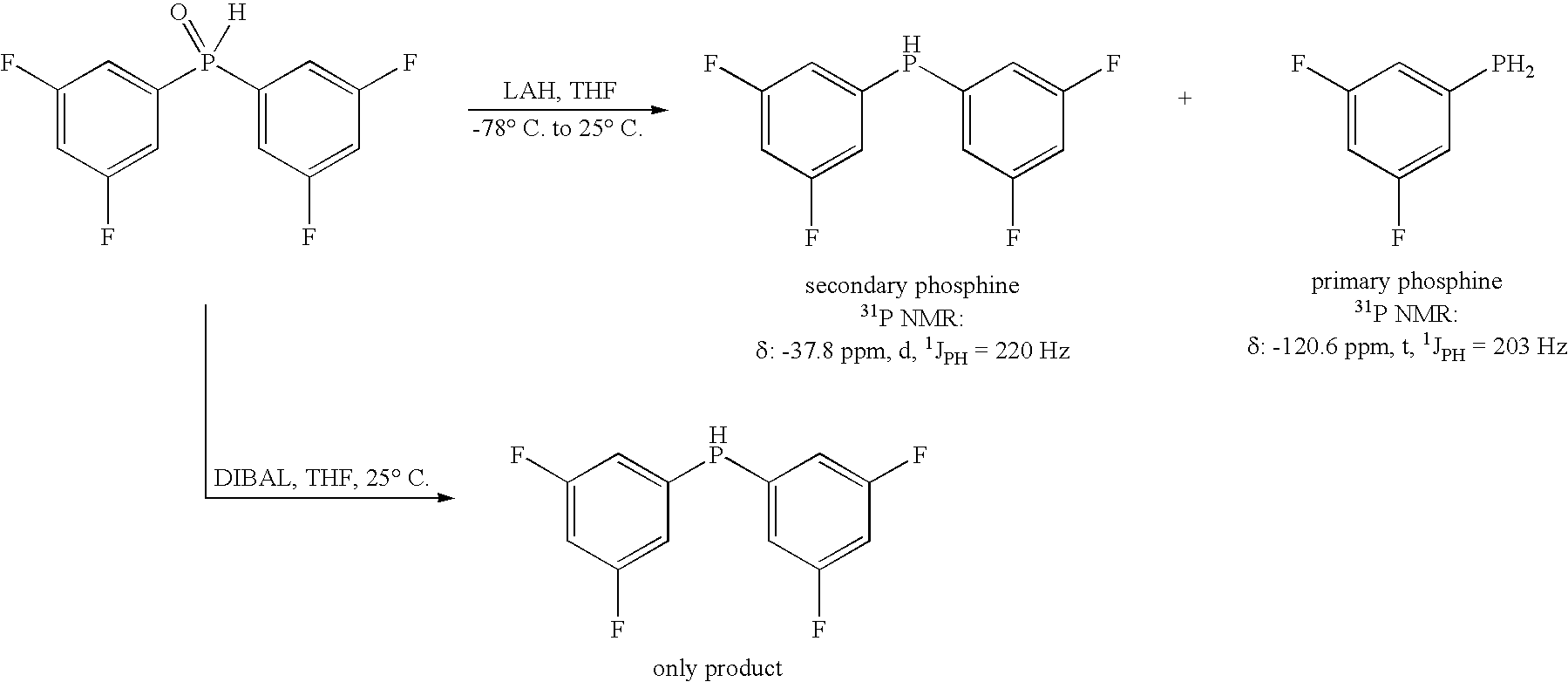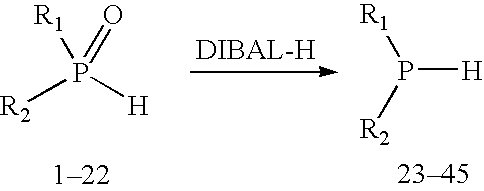Method for generating secondary phosphines
a phosphine and secondary technology, applied in the field of organic compounds, can solve the problems of generating undesirable byproducts, affecting the efficiency of bhsub>3, generating undesirable byproducts, and affecting the efficiency of phosphorus organic compounds, and achieves the effects of less efficient, high average temperature, and quick reduction reactions
- Summary
- Abstract
- Description
- Claims
- Application Information
AI Technical Summary
Benefits of technology
Problems solved by technology
Method used
Image
Examples
example 1
Production of Bis-(3-fluorophenyl) Phosphine by Reduction with DIBAL-H
[0026]
[0027] A 2-neck 100 mL flask with a Vigreux condenser was evacuated / Ar filled (3×), then charged with 6.00 mL 1M DIBAL-H / THF (6.00 mmol, 3 eq.), then heated to 65° C. under N2. To the warm solution, 476 mg bis (3-fluorophenyl)-phosphine oxide (2.00 mmol, 1 eq.) in 4.0 mL THF was added in drops from a syringe over 15 minutes, with caution taken for gas evolution. After one hour at reflux, TLC of a quenched aliquot showed the reaction was complete to a non-polar product. The mixture was cooled to ambient temperature, and then cautiously quenched by the slow addition of 10 mL 5% aqueous NaOH. The mixture was stirred vigorously for 10 minutes, then 10 mL of 1:1 MTBE:Hexane was added, and the mixture was again stirred vigorously for 10 minutes. After stirring was stopped, the phases were allowed to separate, and the upper organic phase was transferred, via canula, under N2 pressure, to an air-free filter funnel ...
example 2
Production of Pheylisopropyl Phosphine by Reduction with Triisobutyldialuminoxane
[0028] A flask was charged with 2.0 mL 0.36M triisobutyldialuminoxane / toluene solution (0.72 mmol, 2 eq.), then cooled to −78° C. under Ar. To this cold solution was then added a solution of 60 mg phenylisopropylphosphine oxide (0.36 mmol, 1 eq.) in 0.75 mL 8d THF. Gas evolution was observed. The flask was then allowed to warm to 25° C. After 2 h at 25° C., 31P NMR of an aliquot showed the reaction was already 50% complete to the desired secondary phosphine, phenylisopropyl phosphine, with 31P NMR δ=−27.4 ppm.
example 3
Production of Pheylisopropyl Phosphine by Reduction with Triisobutylaluminum
[0029] A screw-cap NMR tube was charged with 0.50 mL 1M i-Bu3Al / Hexane solution (0.50 mmol, 1 eq.), then cooled to −78° C. under Ar. To this cold solution was then added a solution of 84 mg Phenylisopropylphosphine oxide (0.50 mmol, 1 eq.) in 0.15 mL 8d THF. Gas evolution was observed. The tube was then allowed to warm to 25° C. After only 15 min. at 25° C., 31P NMR showed the reaction was already 70% complete to the desired secondary phosphine, phenylisopropyl phosphine, with 31P NMR δ=−27.4 ppm.
PUM
 Login to View More
Login to View More Abstract
Description
Claims
Application Information
 Login to View More
Login to View More - R&D
- Intellectual Property
- Life Sciences
- Materials
- Tech Scout
- Unparalleled Data Quality
- Higher Quality Content
- 60% Fewer Hallucinations
Browse by: Latest US Patents, China's latest patents, Technical Efficacy Thesaurus, Application Domain, Technology Topic, Popular Technical Reports.
© 2025 PatSnap. All rights reserved.Legal|Privacy policy|Modern Slavery Act Transparency Statement|Sitemap|About US| Contact US: help@patsnap.com



